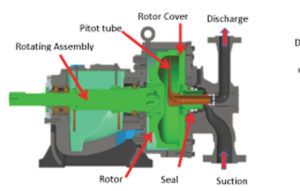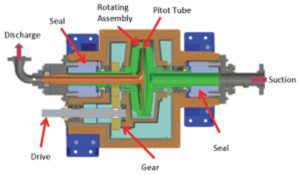What are pitot tube pumps? Where are they used?
While pitot tube pumps have been commercially available since 1970, little is known and less is published about their internal operation and design principles especially when operating off design. Pitot tube pumps are classified as centrifugal pumps since they add energy to the fluid by increasing the fluid angular momentum and such follow many of the same laws. However, due to their unique construction they operate differently than typical “impeller” pumps. Understanding these differences is imperative in their successful application.
This article contains an extract from the paper, “A Study on the Operation of Pitot Tube Pumps,” by Bryce Neilson of Weir Specialty Pumps at the 2018 Asia Turbomachinery & Pump Symposium in Singapore.

Coaxial arrangement[/caption]
Pitot tube pumps excel in low flow, high head applications (nq = 1.2-7 (rpm)) and can operate reliably throughout their full curve (shutoff to runout) without damage. They operate with efficiencies in range of 50%-65%. They can operate at speeds up to 6,000 rpm and can generate heads up to 1,700 m with best efficiency point (BEP) flow rates of 4.5-114 m2 /h without pressure pulsations. Pump capacity is determined by the size and number of pitot tube openings or blades. Pump head is determined by pump speed and diameter of the rotating case.

Flow-through arrangement[/caption]
Since pitot tube pumps do not have an impeller they do not exhibit recirculation or flow separation at flow rates away from the BEP. The hydraulic bearing loads are minimal or non-existent and vary little if at all with respect to flow rate. This extends the allowable flow rate from shut off to the end of curve without incurring any mechanical distress. Pitot tube pumps are capable of low NPSHr without the use of an inducer and exhibit stable suction characteristics through their full operating range.
A mechanical seal(s) is used to seal the rotating case. This seal(s) is exposed to only suction pressure. Besides the items required to support a rotating body (i.e. bearing frame and bearings), all pitot pumps are composed of three major parts. Two of these parts make up the rotating case; the rotor cover and rotor. The pitot tube is placed in the center of the rotating case, and has an opening facing opposite the direction of rotation near the periphery of the case. Fluid enters the opening where the tangential velocity is diffused into pressure and conveyed back to the center of the pump where it is discharged via the shaft supporting the pitot tube (Figures 1 and 2). Pitot tube pumps are most commonly available in either coaxial suction and discharge arrangement (Figure 1) or a flow through arrangement (Figure 2) where the suction and discharge are opposed. The important difference between the two is how the pitot tube penetrates the rotating case. In the coaxial arrangement, the pitot tube penetrates through the eye of rotor cover increasing the NPSHr, especially on light hydrocarbons. This arrangement is subject to hydraulic thrust; however, it requires only one seal.
The coaxial arrangement is typically offered as an overhung rotating case. In the flow through arrangement, the pitot tube penetrates the rotor. This decreases NPSHr and eliminates all hydraulic thrust. The flow through arrangement requires two seals and a tangential drive, this is typically accomplished via a gear drive. The flow through arrangement is typically offered as a between bearings rotating case. Pitot tube pumps typically operate at speeds above two pole motor speeds and require a speed increasing gearbox either mounted external or internal to the bearing frame.
The rotating case is supported by a shaft(s) and is composed of two parts; rotor and rotor cover. The rotor is simply one half of the rotating case that encloses most of the rotating case. Typically, the drive shaft attaches to the rotor. The rotor cover makes up the other half of the rotating case and encloses several radial channels. The form of the channels is much like an impeller in a standard centrifugal impeller pump. These channels aid in increasing the angular momentum of fluid as it travels from the eye or inlet of the rotor cover to the periphery to replace the fluid that flows into the pitot tube. While these channels are not required for operation they increase the efficiency of the pump. These two pieces of the rotating assembly split radially to allow for the installation of the pitot tube. The function of the rotor and rotor cover is to generate and maintain a rotating body of fluid with in the rotating case.
The pitot tube is the diffusing element of the pump. It is a simple tube-like protrusion installed in the middle of the rotating case. It extends radially to the periphery of the rotating case with an opening (or nose) in the radial direction opposite the direction of rotation of the rotating case. The exterior of the pitot tube is streamlined to reduce drag. The internal passage is shaped to reduce friction and diffusion losses. Pitot tubes come as either a single blade and opening or with two blades having two openings.
Fluid in the rotating case is accelerated to and maintained at or near the angular velocity of the rotating case by the rotor and rotor cover. This fluid rotates as a solid body. This differs from a typical impeller pump where the fluid flows at constant rate though the impeller as a function of geometry and the impeller’s angular velocity.